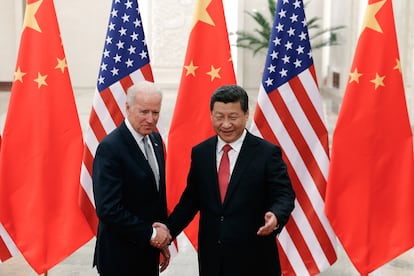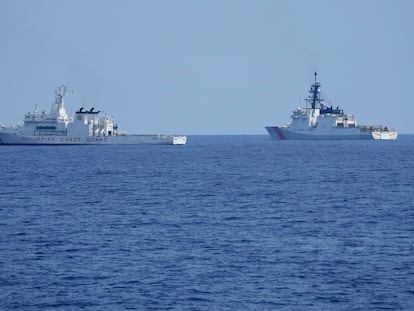The US, Latin America and China: A tense three-way tango
We are now operating under a new scenario, marked not only by the hegemonic decline of the Cold War powers, but also by strategic competition and the need to redefine the course of relations on the American continent

The movements of the tectonic plates of international politics are leading us to the configuration of a system of multiple complexity with different speeds and scopes in its three dimensions: military, economic and cross-cutting issues. The renowned professor Amitav Acharya has baptized this as “Multiplex,” comparing it to a cinema. We are therefore observing several films at the same time, which are determined by the power, geographic scope, leadership and time dimension of the actors involved. Their repercussions at the local level are continuous and delineate the broad lines along which Latin America will have to manage its external relations in the future.
In this context, a recent example that warrants mention is the demand by Latin American academics and progressive personalities for Washington to implement a new “continental pact.” This should favor, according to its authors, the development conditions of the region and redefine the old theories under which the inter-American relationship was maintained in the past. In other words, they demand serious political dialogue and a new system of coexistence with new rules that contribute to development, climate change and the protection of biodiversity. This represents a mature and proper approach in the exercise of a non-aligned foreign policy.
Decades ago, paradoxically, the anti-American sentiment of sectors mainly associated with the left in Latin America set the tone and flew its banners against the Washington Consensus, the Free Trade Area of the Americas (FTAA) and the embargo on Cuba. History has now shifted and we have moved from systematic rejection to a new approach, in a constructive spirit of dialogue
It is clear that we are now operating under a new scenario, marked not only by the hegemonic decline of the Cold War powers, but also by strategic competition and the need to redefine the course of relations on the American continent, based on a comprehensive, constructive agenda that benefits all parties.
Hegemonic decline
The transition from the West to the Asia-Pacific region is leading the globe into a new historical era in which Washington’s hegemonic role is undergoing a process of change and global power is being shared.
Despite internal political tensions and social inequalities, the United States continues and will continue to play a very important leadership role. It will do so in economic, political, military, and intellectual terms.
The central issue — as Fareed Zakaria points out — is not the “decline of America but the emergence of other actors.” Bipolarity between the U.S. and China, accompanied by revisionist countries such as Russia and Iran, will set the tone in a world undergoing configuration. The terms and scope of soft power, credibility, and the ability to network and influence will be under scrutiny.
Strategic competition between China and the United States
This trend has been accentuated in recent years as Beijing has become increasingly open, active and confrontational in its approach to Latin America.
Beijing has openly invited countries in the region to join strategic projects for its global projection, such as the Belt and Road Initiative and the Global Development Initiative. The economic and commercial emphasis has been on obtaining natural resources and primary goods, opening new markets, and investing in infrastructure, innovation, technology and telecommunications.
This strategy has allowed it to become Latin America’s second-largest trading partner after the United States, to flood local markets with consumer and intermediate goods, and to develop an important influence in terms of foreign direct investment in strategic sectors, such as electricity. The figures speak for themselves: trade between the two regions grew by 11% in 2022 and reached $469 billion. Since 2000, Beijing has invested over $172 billion in Latin America.
For its part, the U.S. has maintained a relationship with China characterized by engagement and deterrence, which are intertwined and applied depending on the context. Tensions have increased with the Covid-19 pandemic and the rise of President Xi Jinping and his more ambitious vision of illiberal democracy, greater control and repression, and state capitalism. Competition and rivalry will be the order of the day, as will decoupling. For some analysts, such as Wang Huiyao, president of the Center for China and Globalization in Beijing, this process has become irreversible and may lead to the “breaking of the system into two parts.”
In response, President Biden’s administration has shown interest in regaining lost ground in Latin America, especially in terms of dialogue and influence, and in advancing the consolidation of a hemispheric community around respect for, and promotion of democracy, human rights and sustainable development goals. The Alliance for Development in Democracy between Costa Rica, the United States, Panama and the Dominican Republic is a good example of this.
The U.S. remains the region’s main trading partner and has positioned itself, along with the European Union, as one of the largest foreign investors with 34% of total FDI.
However, Alicia García Herrero, chief economist for Asia Pacific at French investment bank Natixis, believes that while China’s influence may seem unstoppable, “the reality is that both the U.S. and the European Union have made it very easy for China. Both economic blocs have not taken the importance of reaching trade and investment agreements with Latin America seriously enough and have lost ground in the region.”
In short, China has seized the opportunity and filled an empty space, by omission of a third party, and it has done so astutely and decisively.
New hemispheric relations
For the vast majority, the last Summit of the Americas was a historic opportunity to relaunch hemispheric relations in a period marked by the serious aftereffects of the pandemic.
It was time to “look again to Latin America” in order to re-engage and launch a major program of inter-American collaboration on cross-cutting issues. This would provide the United States with an opportunity to reach out to the “pink tide” and to jointly build a long-term vision. It would also give it a comparative advantage, by turning its attention back to issues in which China’s foreign policy has traditionally been absent or uninterested in engaging.
Despite the efforts deployed in Los Angeles and the Americas Partnership for Economic Prosperity agreement, some question the results obtained and the lack of implementation. It is therefore necessary to strengthen dialogue and cooperation under a comprehensive and pragmatic agenda that involves both the public and private sectors. It is an exercise in reinvention and the projection of interests that leaves ideological differences aside and takes into consideration the heterogeneity, priorities and enormous political complexity of Latin America.
Among the central elements for Washington’s regional, sub-regional and bilateral engagement should be: growth with equity, climate change and energy transition, digital transformation, infrastructure, education, health, trade, relocation and investment, migration, drugs and transnational crime. It is about building a positive and strategic agenda that transcends traditional issues and provides alternatives. It must also be accompanied by new tools that promote cooperation over confrontation.
Democracy, as a pillar of our relationship, requires a special chapter and a multilateral approach, given the progressive deterioration of some regimes in the region and their populist and authoritarian tendencies. The political situation in certain countries cannot be understood under the notion of “building a narrative of authoritarianism,” as it was presented a few days ago. Reports from the United Nations, the Inter-American Commission on Human Rights and Human Rights Watch, in addition to investigations by the International Criminal Court, speak volumes. The final blow was provided by presidents Gabriel Boric of Chile and Lacalle Pou of Uruguay at the last South American summit in Brazil, when they openly disputed this approach. From different political shores, they acted in unison and ratified an unquestionable reality. The defense of democracy in the region has no political color or flag. It is everyone’s duty and responsibility. Dialogue, the strengthening of institutions and a clear vision of the future will be decisive in this stage.
The call for a new inter-American agenda is a collective aspiration to strengthen collaboration with the option of exercising a role of greater autonomy and independence on the part of Latin America. We must move from the Washington Consensus toward a new Global South Consensus.
In the development of this hemispheric agenda, multilateral financial organizations such as the Inter-American Development Bank, CAF-Development Bank of Latin America, and the World Bank, have an essential role to play, providing not only resources for projects with high social and economic impact, but also innovative solutions, technical support and relevant knowledge.
Concluding remarks
Latin America has the urgent task of undertaking a series of internal reforms to address the most pressing development problems within the framework of the 2030 Agenda. This is its own task, the design and implementation of which corresponds to the region. Its success or failure cannot be attributed to outsiders. There can be no excuses. Without constructive leadership, greater growth and regional integration, there is a serious risk of international irrelevance, which is already becoming evident in some global forums.
The region also faces the strategic challenge of balancing its relationship with the United States and China, and not falling into a trap. These are not mutually exclusive options. On the contrary, they are valid and compatible alternatives that can coexist simultaneously and contribute — each from its strengths and virtues — to well-being. New reliable partners, markets and quality investments will always be welcome.
In short, we are facing a tense tango for three: the U.S., Latin America, and China. This is a dance that, since its late 19th-century origins in the Río de la Plata, has been a response to and a lively expression of the search for identity and freedom. It has — as does international politics — diverse steps and movements, actors and instruments, hopes and even passions. We must return to the past to remember the present and, above all, to think about the future.
Sign up for our weekly newsletter to get more English-language news coverage from EL PAÍS USA Edition
Tu suscripción se está usando en otro dispositivo
¿Quieres añadir otro usuario a tu suscripción?
Si continúas leyendo en este dispositivo, no se podrá leer en el otro.
FlechaTu suscripción se está usando en otro dispositivo y solo puedes acceder a EL PAÍS desde un dispositivo a la vez.
Si quieres compartir tu cuenta, cambia tu suscripción a la modalidad Premium, así podrás añadir otro usuario. Cada uno accederá con su propia cuenta de email, lo que os permitirá personalizar vuestra experiencia en EL PAÍS.
¿Tienes una suscripción de empresa? Accede aquí para contratar más cuentas.
En el caso de no saber quién está usando tu cuenta, te recomendamos cambiar tu contraseña aquí.
Si decides continuar compartiendo tu cuenta, este mensaje se mostrará en tu dispositivo y en el de la otra persona que está usando tu cuenta de forma indefinida, afectando a tu experiencia de lectura. Puedes consultar aquí los términos y condiciones de la suscripción digital.
More information
Archived In
Últimas noticias
Sydney Sweeney, the actress praised by Trump: ‘Women are up against what society wants them to be’
The Bolsonaro surname: An advantage or liability in Brazil’s 2026 presidential elections?
Raúl Rocha, from jet-setting with Miss Universe to arms trafficking and fuel theft
80,000 barrels of Mexican oil sent to Cuba: Havana drawn into the US–Mexico clash
Most viewed
- Reinhard Genzel, Nobel laureate in physics: ‘One-minute videos will never give you the truth’
- Pablo Escobar’s hippos: A serious environmental problem, 40 years on
- Charles Dubouloz, mountaineering star, retires at 36 with a farewell tour inspired by Walter Bonatti
- Why we lost the habit of sleeping in two segments and how that changed our sense of time
- The fall of a prolific science journal exposes the billion-dollar profits of scientific publishing










































